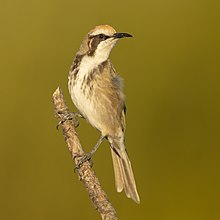Tawny-crowned honeyeater
| Tawny-crowned honeyeater | |
|---|---|

| |
| Scientific classification | |
| Kingdom: | Animalia |
| Phylum: | Chordata |
| Class: | Aves |
| Order: | Passeriformes |
| Family: | Meliphagidae |
| Genus: | Gliciphila Swainson, 1837 |
| Species: | G. melanops
|
| Binomial name | |
| Gliciphila melanops Latham 1801
| |
| Synonyms | |
| |
The tawny-crowned honeyeater (Gliciphila melanops) is a passerine bird native to southern Australia.
Taxonomy[]
The tawny-crowned honeyeater was originally described by ornithologist John Latham in 1801 as Certhia melanops.[1] Its specific epithet is derived from the Ancient Greek terms melano- 'black' and ōps 'face'.[2]
It was previously classified in the genus Phylidonyris but a recent molecular study has shown it to be more distantly related to members of that genus.[3] It was placed in the genus Gliciphila by Gregory Mathews in 1912, and this name was used in its current binomial name. DNA analysis has shown honeyeaters to be related to the Pardalotidae (pardalotes), Acanthizidae (Australian warblers, scrubwrens, thornbills, etc.), and Maluridae (Australian fairy-wrens) in the large superfamily Meliphagoidea.[4]
There are two recognized subspecies of tawny-crowned honeyeater: the nominate race, G. melanops melanops, and G. melanops chelidonia. G. melanops chelidonia is endemic to Tasmania and has a rufous tinge to its plumage.[5]
Distribution[]
The tawny-crowned honeyeater is found from the North Coast of New South Wales through to the Eyre Peninsula in South Australia, as well as in Victoria and Tasmania. It also occurs in southwest Western Australia from Israelite Bay westwards. Its natural habitat is low shrubland and heath.[6] It has been extirpated from urban Sydney since 1971.[5]
Breeding[]
The breeding season may take place from June to December. The bulky cup-shaped nest is made of bark, grass, and even seaweed, and lined with softer material such as fur or wool. It is hidden among shrubby vegetation. The clutch size is usually two or three, and occasionally four. Measuring 21 x 14 mm, the oval eggs are beige, with buff or pink-tinged splotches.[6]
Gallery[]
References[]
- ^ Latham, John (1801). Supplementum indicis ornithologici sive systematis ornithologiae (in Latin). London: Leigh & Sotheby. p. xxxvi.
- ^ Liddell, Henry George and Robert Scott (1980). A Greek-English Lexicon (Abridged ed.). United Kingdom: Oxford University Press. ISBN 0-19-910207-4.
- ^ Driskell, A.C., Christidis, L (2004) Phylogeny and evolution of the Australo-Papuan honeyeaters (Passeriformes, Meliphagidae) Molecular Phylogenetics and Evolution 31 943–960
- ^ Barker, F.K., Cibois, A., Schikler, P., Feinstein, J., and Cracraft, J (2004) Phylogeny and diversification of the largest avian radiation. Proceedings Natl. Acad. Sci., USA 101 11040-11045
- ^ a b Higgins, Peter; Christidis, Les; Ford, Hugh (2020-03-04), Billerman, Shawn M.; Keeney, Brooke K.; Rodewald, Paul G.; Schulenberg, Thomas S. (eds.), "Tawny-crowned Honeyeater (Gliciphila melanops)", Birds of the World, Cornell Lab of Ornithology, doi:10.2173/bow.tachon1.01, retrieved 2020-11-02
- ^ a b Beruldsen, G (2003). Australian Birds: Their Nests and Eggs. Kenmore Hills, Qld: self. p. 324. ISBN 0-646-42798-9.
- Meliphagidae
- Birds of New South Wales
- Birds of Victoria (Australia)
- Birds of South Australia
- Birds of Western Australia
- Birds of Tasmania
- Birds described in 1837
